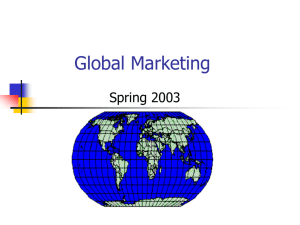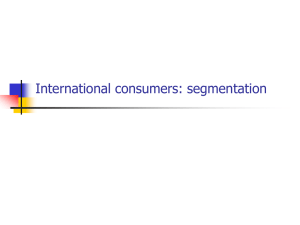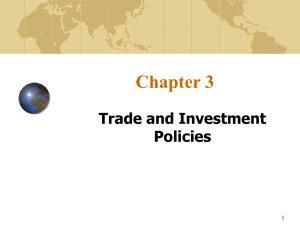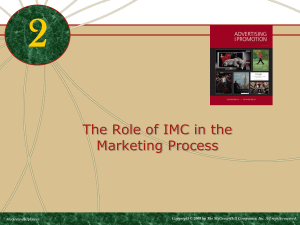Chapter7-8modified
advertisement
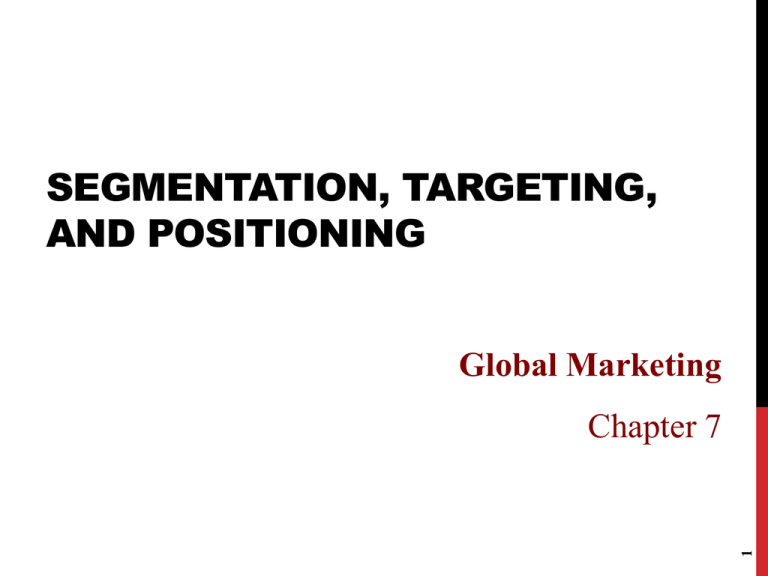
SEGMENTATION, TARGETING, AND POSITIONING Global Marketing 1 Chapter 7 MARKET SEGMENTATION 7-2 Represents an effort to identify and categorize groups of customers and countries according to common characteristics TARGETING The process of evaluating segments and focusing marketing efforts on a country, region, or group of people that has significant potential to respond 7-3 Focus on the segments that can be reached most effectively, efficiently, and profitably POSITIONING 7-4 Positioning is required to differentiate the product or brand in the minds of the target market. GLOBAL MARKET SEGMENTATION 7-5 Defined as the process of identifying specific segments—whether they be country groups or individual consumer groups—of potential customers with homogeneous attributes who are likely to exhibit similar responses to a company’s marketing mix. CONTRASTING VIEWS OF GLOBAL SEGMENTATION • Assumes heterogeneity between countries • Assumes homogeneity within a country • Focuses on macro level of cultural differences • Relies on clustering of national markets • Less emphasis on within-country segments Unconventional Wisdom • Assumes emergence of segments that transcend national boundaries • Recognizes existence of within-country differences • Emphasizes microlevel differences • Segments micro markets within and between countries 7-6 Conventional Wisdom GLOBAL MARKET SEGMENTATION Demographics Psychographics Behavioral characteristics 7-7 Benefits sought DEMOGRAPHIC SEGMENTATION Income Population Age distribution Gender Education Occupation 7-8 What are the trends? AGE SEGMENTATION Global Teens–young people between the ages of 12 and 19 • A group of teenagers randomly chosen from different parts of the world will share many of the same tastes 7-9 Global Elite–affluent consumers who are well traveled and have the money to spend on prestigious products with an image of exclusivity GENDER SEGMENTATION In focusing on the needs and wants of one gender, do not miss opportunities to serve the other Companies may offer product lines for both genders 7-10 • Nike, Levi Strauss PSYCHOGRAPHIC SEGMENTATION Grouping people according to attitudes, values, and lifestyles 7-11 • • • • • Porsche example from SRI International Top Guns (27%): Ambition, power, control Elitists (24%): Old money, car is just a car Proud Patrons (23%): Car is reward for hard work Bon Vivants (17%): Car is for excitement, adventure Fantasists (9%): Car is form of escape BEHAVIOR SEGMENTATION Focus on whether people purchase a product or not, how much, and how often they use it User status 7-12 Law of disproportionality/Pareto’s Law–80% of a company’s revenues are accounted for by 20% of the customers BENEFIT SEGMENTATION Benefit segmentation focuses on the value equation 7-13 • Value=Benefits/Price Based on understanding the problem a product solves, the benefit it offers, or the issue it addresses ETHNIC SEGMENTATION countries includes ethnic groups of significant size • 40+ million Hispanic Americans (14% of total pop.) with $560 billion annual buying power • CA Mexicans have after-tax income of $100 billion • The number of Hispanic teens will rise from 12 percent of the U.S. teen population to 18 percent in the next decade 7-14 The population of many Hispanic Americans TARGET MARKETING STRATEGIES 15 CONCENTRATED MARKETING The focus is acquiring a large share of one or a few segments of niches. Generally, there are fewer competitors. The Internet is ideal for targeting small niche markets. There is some risk in focusing on only one market. 16 TARGET MARKET STRATEGY OPTIONS • Niche marketing • Single segment of global market • Look for global depth rather than national breadth • Ex.: Chanel, Body Shop • Multi-segment targeting • Two or more distinct markets • Wider market coverage • Ex.: P&G markets Old Spice and Hugo Boss for Men 7-17 Concentrated global marketing Differentiated global marketing DIFFERENTIATED/ MULTI SEGMENT MARKETING Firm targets several market segments and designs separate offers for each. The goal is to have higher sales and a stronger position with each market segment. This approach increases the costs of doing business. 18 POSITIONING Locating a brand in consumers’ minds over and against competitors in terms of attributes and benefits that the brand does and does not offer Attribute or Benefit Quality and Price Use or User Competition 7-19 • • • • POSITIONING MAP 6-20 POSITIONING STRATEGIES Global consumer culture positioning • Identifies the brand as a symbol of a particular global culture or segment • High-touch and high-tech products Foreign consumer culture positioning Beer is associated with this German’s culture; the symbol on his shirt is not German! 7-21 • Associates the brand’s users, use occasions, or product origins with a foreign country or culture 7-22 POSITIONING STRATEGIES Local consumer culture positioning 7-23 • Identifies with local cultural meanings • Consumed by local people • Locally produced for local people • Used frequently for food, personal, and household nondurables IMPORTING, EXPORTING, AND SOURCING Global Marketing 24 Chapter 8 INTRODUCTION This chapter looks at: • Export selling and export marketing • Organizational export activities • National policies on imports and exports • Tariff systems • Key export participants 8-25 Export Selling vs. Export Marketing Export selling involves selling the same product, at the same price, with the same promotional tools in a different place Export marketing tailors the marketing mix to international customers 8-26 REQUIREMENTS FOR EXPORT MARKETING An understanding of the target market environment The use of market research and identification of market potential Decisions concerning product design, pricing, distribution and channels, advertising, and communications 8-27 NATIONAL POLICIES GOVERNING EXPORTS AND IMPORTS Most nations encourage exports and restrict imports Goods and services imported into the U.S. almost doubled in seven years In 2008, the total was $2.5 trillion 8-28 GOVERNMENT PROGRAMS THAT SUPPORT EXPORTS Tax incentives Subsidies Governmental assistance Free trade zones 8-29 GOVERNMENTAL ACTIONS TO DISCOURAGE IMPORTS AND BLOCK MARKET ACCESS Tariffs ( “Three R’s”) Nontariff barriers • Quotas • Discriminatory procurement policies • Restrictive customs procedures • Arbitrary monetary policies • Restrictive regulations 8-30 Port Authority of Thailand: Laem Chabang EXAMPLES OF TRADE BARRIERS Table 8.3 p. 277 EU- 16.5% antidumping tariffs on Shoes from China 10% on shoes from Vietnam China- 28% on foreign made auto parts 8-31 GOVERNMENTAL ACTIONS TO DISCOURAGE IMPORTS A nontariff trade barrier (NTB) is any measure other than a tariff that is an obstacle to the sale of products in a foreign market. NTBs are also known as hidden trade barriers. A quota is a government-imposed limit or restriction on the number of units or the total value of a particular product or product category that can be imported. • In 2005, for example, textile producers in Italy and other European countries were granted quotas on 10 categories of textile imports from China. Discriminatory procurement policies can take the form of government rules and administrative regulations that give local vendors priority. • The Buy American Act of 1993 8-32 TARIFF SYSTEMS Single-column tariff • Simplest type of tariff • Schedule of duties in which rate applies to imports from all countries on the same basis Two-column tariff • General duties plus special duties apply 8-33 TARIFF SYSTEMS 8-34 Sample Rates of Duty for U.S. Imports PREFERENTIAL TARIFF Reduced tariff rate applied to imports from certain countries GATT prohibits the use, with three exceptions: • Historical preference arrangements already existed • Preference is part of formal economic integration treaty • Industrial countries are permitted to grant preferential market access to LDCs 8-35 CUSTOMS DUTIES Ad valorem duty • Expressed as percentage of value of goods Specific duty • Expressed as specific amount of currency per unit of weight, volume, length, or other unit of measurement • $1 per pair of Shoes • 1000 Baht per ton of the goods imported Compound or mixed duties • Apply both ad valorem and specific on the same items 8-36 OTHER DUTIES AND IMPORT CHARGES Anti-dumping Duties • Dumping is the sale of merchandise in export markets at unfair prices • Special import charges equal to the dumping margin • 48.5% added to tax against Chinese imports of bicycles in EU Countervailing Duties • Added duties to offset the subsidies granted in the export countries Temporary Surcharges 8-37 Key Export Participants (Self Study) Foreign purchasing agents Export brokers Export merchants Export management companies Export distributor Export commission representative Cooperative exporter Freight forwarders Manufacturer’s export representatives 8-38 ORGANIZING FOR EXPORTING IN THE MARKET COUNTRY Direct market representation • Advantages: control and communications Representation by independent intermediaries • Advantages: best for situations with small sales volume 8-39 EXPORT FINANCING AND METHODS OF PAYMENT Documentary credits (Letter of Credit) Documentary collections (Bill of Exchange) Cash in advance Sales on open account 8-40 FLOW CHART OF DOCUMENTARY CREDIT 8-41 8-42 8-43 SOURCING Must emphasize benefits of sourcing from country other than home country Must assess vision and values of company leadership Advantage can be gained by • Concentrating some of the marketing activities in a single location • Leveraging company’s know-how • Tapping opportunities for product development and R&D 8-44 8-45 FACTORS THAT AFFECT SOURCING Management vision Factor costs and conditions Customer needs Logistics Country infrastructure Political risk Exchange rate, availability, and convertibility of local money 8-46 DUTY DRAWBACK Refunds of duties paid on imports that are processed or incorporated into other goods AND re-exported Reduce the price of imported production inputs Used in the U.S. to encourage exports After NAFTA, U.S. reduced drawbacks on exports to Canada and Mexico China had to reduce drawbacks in order to join the WTO 8-47 LOOKING AHEAD TO CHAPTER 9 Global Market Entry Strategies: Licensing, Investment, and Strategic Alliances 8-48



